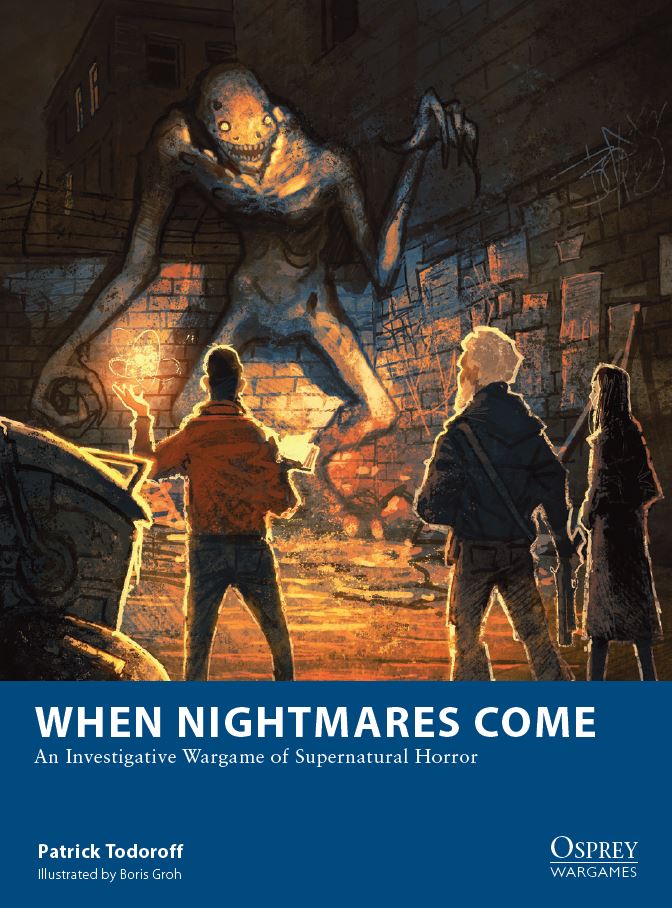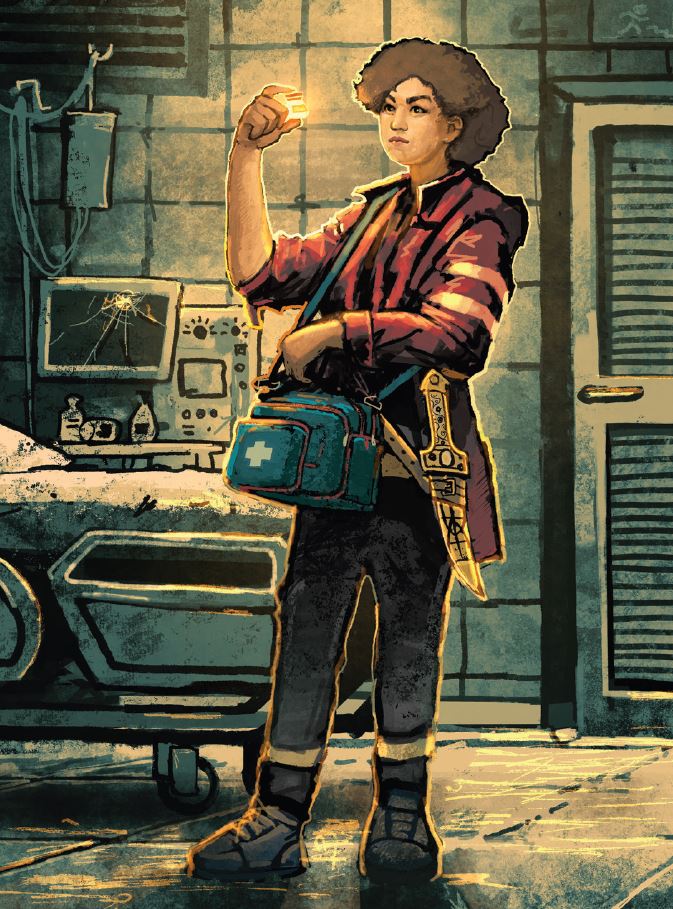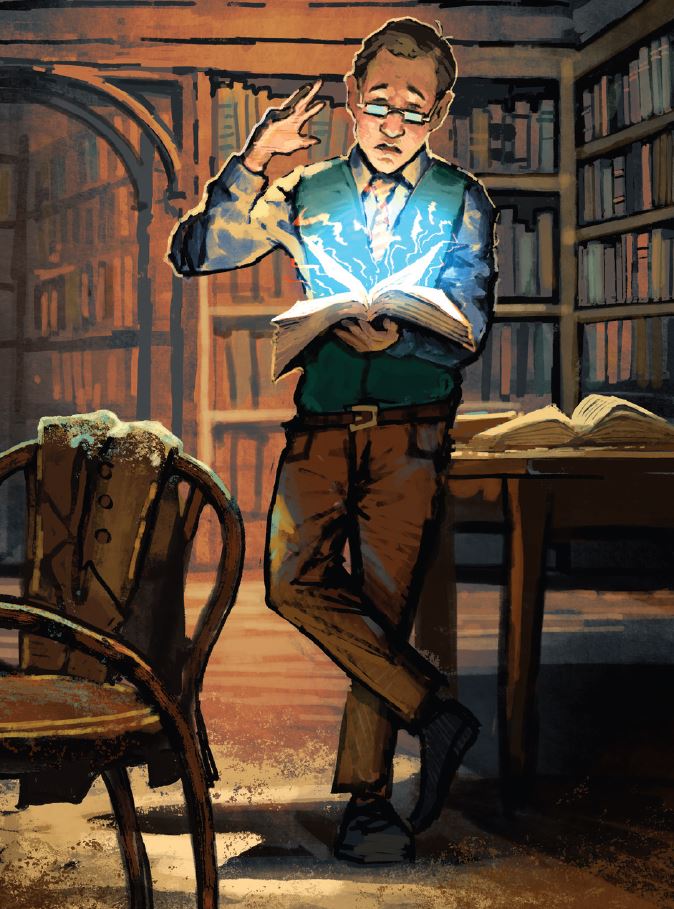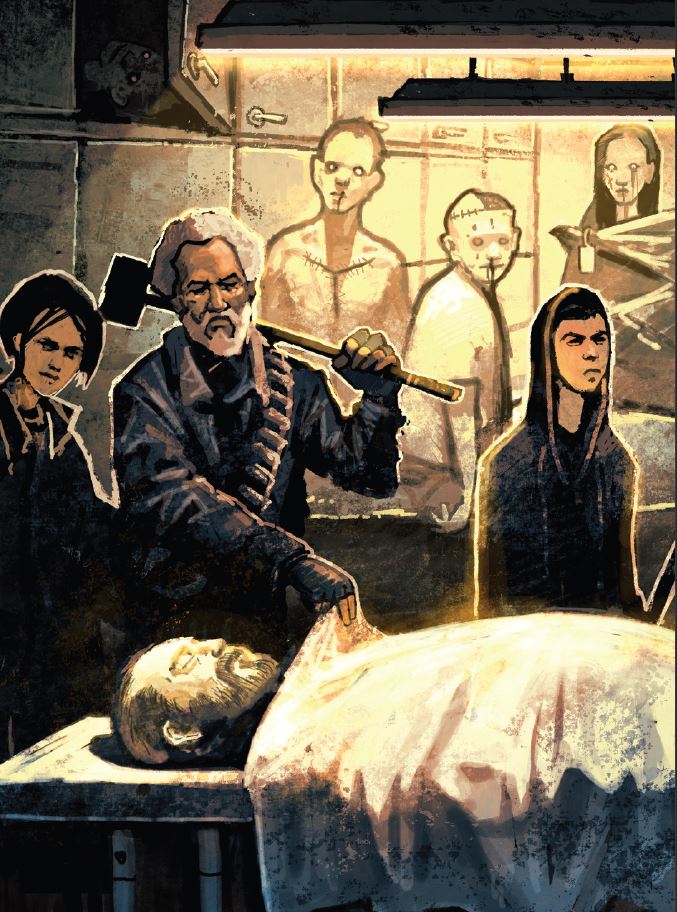When Nightmares Come – An Impressive Urban Fantasy Wargame | First Impressions
February 3, 2024 by brennon
When Osprey Games recently announced a new wargame coming out from Patrick Todoroff who had previously worked on Zona Alfa I was intrigued to find out more. When I found out that When Nightmares Come was an awesome Supernatural Horror investigative wargame I was sold!
I have been a fan of the World Of Darkness, The Dresden Files and all sorts of Urban Fantasy stories for the longest time and so I was very happy to be able to get a look at what When Nightmares Come: An Investigative Wargame of Supernatural Horror is offering to those looking for a different miniature wargaming experience on the tabletop.
The Haunting Premise
When Nightmares Come (abbreviated to Nightmares) is a game of strange disturbances and things that go bump in the night, set against the backdrop of the modern day. Whilst our cities are flooded with light and sound and we feel safe when we lock the doors, something still stirs in the dark corners of the world and that's what you've been tasked to uncover and perhaps vanquish. As a cooperative miniatures game, you take on the role of paranormal vigilantes, occult specialists and monster hunters who come under the banner of the Nightwatch.
If you've ever played the likes of Hunter: The Reckoning, read a Dresden Files novel or watched Buffy, The Vampire Slayer then you'll be in the right neck of the haunted woods. All of this already had me excited, especially with the premise of this being a solo and/or cooperative game so it becomes a challenge between your friends and the "game". What's also nice about the game is that it uses the regular 28mm miniatures that most of us have in our collection already and only plays out on a 2x2 foot playing space. Perfect for those looking to fit in games in their cramped hobby rooms or kitchens.
The other aspect of Nightmares that immediately got me excited is the potential to explore different miniature ranges. Todoroff wanted Nightmares to be open to whatever miniatures you have in your collection. That seems like a damn good invitation to go and explore the Pulp ranges from the likes of Crooked Dice, Hasslefree Miniatures and more to find suitable Nightwatch members to make up your little gang. Any game that gets you diving into the various indie ranges out there has to be commended.
Anyway, before I get sidetracked and end up not writing this article as I go off scouting out different miniatures, it's worth returning to the central premise of the game. Nightmares takes place during a mini-campaign that takes place over the course of a handful of games or sessions. Yes, you will have tabletop encounters where you find yourself battling the forces of evil but Nightmares also features a novel idea in the addition of narrative encounters where you and your friends plot out non-combat investigations, sleuthing and more which then ends up having an impact on what happens when you finally clash with your enemies! You always need a good library session if Rupert Giles and Bob The Skull have taught me anything.
This leads to what I think could be a fascinating game that takes a lot of what has made games over the past few years so successful (The Silver Bayonet and Rangers Of Shadow Deep for example) and turns it up a notch. I think that in the last few years, people have been searching for more narrative in their games and a chance to tell stories at the tabletop with their friends. The aforementioned games do that through the way they tell interesting stories in their scenario creation but I think Patrick Todoroff has done a sterling job here of blending in elements of the roleplaying game genre whilst not feeling like it overwhelms the idea of "awesome monster hunting miniature wargaming".
Malefic Core Mechanics!
As mentioned above, Nightmares is split into its narrative and tactical side and that comes through in the basic mechanics of the game. When creating their Hunters, players will come up with a statline that helps them in narrative segments which then works differently in a tactical encounter. On the narrative side of things, players use the dice of the game (d6, d8 and d10) and assign them to their Body, Mind and Spirit. You'll then choose a class for your character. That could be the monster-hunting Warden, the magically inclined Weaver or the researchers and tinkerings that make up the Wrights. You'll want a good balance in your group but of course, you can choose whatever you like.
Whilst the dice that you assign to your Body, Mind and Spirit are tied to those particular stats for your narrative encounters, the fun thing is that when you switch over to a tactical scenario, those dice become available for you to use in whichever actions you'd like to undertake. So yes, you might be the Warden holding the fort against a rampaging horde of shadow demons but maybe this time you use your d10 to try and break the code on a mystical lock that might just save your friends in a pinch! I like this, as I reckon it could lead to some exciting cinematic moments!
What's fun is that Todoroff has worked in diminishing returns to this mechanic. So yes, you have all of those dice available to you on your turn but you can only use each once per activation. You used the d10 to seal the magical lock but now you're stuck with a d6 or a d8 to hold off the beast that burst through at the last second. Ok, you've used your d8 to blast that one away but now you've only got a d6 to pull off that last skill check!
Your class does give you a specific advantage in certain situations though. A Warden will always get a bonus when doing anything related to fighting in ranged and melee combat for example. Your characters then get access to special skills and a whole bunch of different types of equipment that could be used to combat the supernatural forces they find standing between them and success.
You can get your hands on loads of different types of equipment, spells you can learn, rituals you can practise and much more. Todoroff has not skimped on the options available to players when making their Hunters feel unique.
Narrative & Tactical Scenes
There are lots more intricacies to how the mechanics work but I want to now turn to the actual games themselves. As I mentioned earlier, Nightmares takes place over the course of a mini-campaign where each mission is split in two. You start with a narrative scene before moving into a tactical one. When diving into a mission you determine What? Where? Who? and When? by rolling on a series of tables in the book which highlight the different happenings in Deacon Falls (the default setting for the game).
Once you've rolled on those tables you'll generate a series of Challenges (normally between one and three) that the players will have to overcome using their narrative stat line. The way that these challenges are solved and what they are are totally up to the players. For example, you've arrived at the docks to investigate a haunting but you decide the gates are locked because of the circumstances of your rolls earlier. How do you get in? Roll Body and try and break them down? Maybe you use Spirit and try and charm your way in by convincing a scared guard to open up?
Depending on the results of your Challenges (which can be influenced by your character's connections and more), you'll either end up with a Win, Draw or Loss at the end of a narrative encounter. It's a fun little option for helping to heighten the tension and throws you into some fascinating situations where you might get the drop on your enemies or find yourself in a terrible situation that becomes a desperate struggle! Todoroff has also said you can just ignore this if you'd just prefer to do some fighting. I won't be doing that!
A tactical encounter then takes place over a handful of turns where you need to very quickly search places of interest to find clues and shut down the Nexus where the Dark Spawn are coming from. As you can imagine, that's quite a tight time limit and so your hunters are going to have to be quick on their feet and make some tough decisions if they want to claim victory!
Deadly Dark Spawn Foes
I suppose I should talk about Dark Spawn now I've mentioned your enemies! No mission is ever going to be swings and roundabouts and your foe is going to be the Dark Spawn that could take all manner of different forms. Maybe they're a vampire coven or a gaggle of undead entities that have dragged themselves from the grave. The world is your oyster on that front and you can pretty much take whatever you like from your collection and use them in your games.
The only thing that you need to work out is what level of foes you're going to be facing (usually dictated by the mission). A Vermin is a very basic foe. A Horde is a little more deadly. A Terror ramps things up a bit. Finally, there is the Atrocity which acts as the final boss for a campaign.
As Nightmares is a cooperative game, Dark Spawn have a basic AI system that governs their actions and their overriding focus is to kill you in the most glorious way possible. To that end, they will hunt down obvious threats and move towards them, acting just like a Hunter in rolling a dice and aiming to get that four plus to succeed in wounding you or ripping your face off in some spectacular way.
The book contains two sets of sample adversaries but you're encouraged to come up with your own ideas based on your collection. You can get started with their Strigoi and Eldritch Adversaries first though in your initial games. It's not hard to make your own foes though! Have a look at some of the art in the book and start working out zombie hordes and more.
Oh, So Much More!
This is only the briefest overview of some of the aspects of Nightmares that caught my eye. There is a lot more packed into the eighty pages for you to explore that should hopefully intrigue you if this preview has lured you in.
For example, I like the simple way damage is dealt with in Nightmares and how you can be properly brutal and just kill off your characters when they fall OR have them come back a little bit wrong. It's a great way of building more narrative into the game whilst also making each encounter a daunting experience you want to properly prepare for!
Patrick Todoroff has done a sterling job with When Nightmares Come and I also have to doff my cap to the artist, Boris Groh, who has filled the book with some wonderful illustrations that serve as perfect inspiration for where you can take your games and the hobby that will hopefully grow up around it.
Pre-orders are available right now from Osprey Games ahead of the 28th March release and I would heartily encourage you to dive in and give When Nightmares Come a go when it launches.
Drop your thoughts below...
"You always need a good library session if Rupert Giles and Bob The Skull have taught me anything..."
Supported by (Turn Off)
Supported by (Turn Off)
"There is a lot more packed into the eighty pages for you to explore..."
Supported by (Turn Off)















































































If only there was a YouTube channel out there that could run through some of the mini-manufacturing websites to show what figures would be good to purchase alongside the book.
Sounds like a good idea to me haha
Maybe they could focus on one each week
Nah, it’ll never catch on….
Looks like I might have something to suggest to my friends for an alternate game to the one we just started. Hell, they might just jump ship and go all in from the premise.
I think I like the sounds of this, I’ll probably pick it up and give it a read.
Showing my age here but it gives me Scooby Doo vibes. Looking forward to unmasking the villain at the end of each mission ???
That does sound very cool. Do I need another Cooked Dice order?
?????? WoW i LOVE that, i love so much! I wish this game launch on spanish (for now we only have stargrave and frostgrave i been a lot of time waiting for cyberpunk escenario translate) Remenber me to secret world mmorpg, vampire or unknow army, i LOVE that I hace a lot of urban minis from zombicide and punkapocalyptic what i can use, and i knew being a good idea to collect proxies from horror fictions that i love, i add a Chucky miniature a fee months ago, and the creepy rabbit from malifaux for punka, and this game open… Read more »
I already have the Black Powder version of Nightwatch, this is a no -brainer for me, essential purchase.
Could be great for using Battle Systems modern terrain sets….